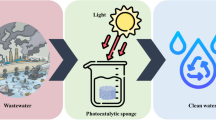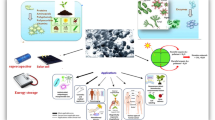Abstract
A laser-based method was developed for the synthesis and simultaneous deposition of multicomponent hybrid thin layers consisting of nanoentities, graphene oxide (GO) platelets, transition metal oxide nanoparticles, urea, and graphitic carbon nitride (g-C3N4) for environmental applications. The photocatalytic properties of the layers were tested through the degradation of methyl orange organic dye probing molecule. It was further demonstrated that the synthesized hybrid compounds are suitable for the photodegradation of chloramphenicol, a widely used broad-spectrum antibiotic, active against Gram-positive and Gram-negative bacteria. However, released in aquatic media represents a serious environmental hazard, especially owing to the formation of antibiotic-resistant bacteria. The obtained results revealed that organic, urea molecules can become an alternative to noble metals co-catalysts, promoting the separation and transfer of photoinduced charge carriers in catalytic composite systems. Laser radiation induces the reduction of GO platelets and the formation of graphene-like material. During the same synthesis process, g-C3N4 was produced, by laser pyrolysis of urea molecules, without any additional heat treatment. The layers exhibit high photocatalytic activity, being a promising material for photodegradation of organic pollutants in wastewater.










Similar content being viewed by others
References
Fujishima A, Honda K (1972) Electrochemical photolysis of water at a semiconductor electrode. Nature 238:37–38
Zaleska-Medynska A, Korotchenkov G (eds) (2018) Metal-oxide based photocatalysis: fundamentals and prospects for application. Elsevier, Amsterdam
Wang H, Zhang L, Chen Z, Hu J, Li S, Wang Z, Liu J, Wang X (2014) Semiconductor heterojunction photocatalysts: design, construction, and photocatalytic performances. Chem Soc Rev 43:5234–5244
Ren H, Koshy P, Chen WF, Qi S, Sorrell CC (2017) Photocatalytic materials and technologies for air purification. J Hazardous Mater 325:340–366
Binas V, Venieri D, Kotzias D, Kiriakidis G (2017) Modified TiO2 based photocatalysts for improved air and health quality. J Materiomics 3:3–16
Stefanakis AI, Becker JA (2015) A review of emerging contaminants in water: classification, sources, and potential risks, in Impact of water pollution on human health and environmental sustainability. In: McKeown AE, Bugyi G (eds) Practice, progress, and proficiency in sustainability book series. IGI Global, Vancouver
Grenni P, Ancona V, Caracciolo AB (2018) Ecological effects of antibiotics on natural ecosystems: a review. Microchem J 136:25–39
Schneider J, Matsuoka M, Takeuchi M, Zhang J, Horiuchi Y, Anpo M, Bahnemann DW (2014) Understanding TiO2 photocatalysis: mechanisms and materials. Chem Rev 114:9919–9986
Ola O, Maroto-Valer MM (2015) Review of material design and reactor engineering on TiO2 photocatalysis for CO2 reduction. J Photochem Photobiol C Photochem Rev 24:16–42
Park H, Kim HI, Moon GH, Choi W (2016) Photoinduced charge transfer processes in solar photocatalysis based on modified TiO2. Energy Environ Sci 9:411–433
Wei Z, Janczarek M, Endo M, Wang K, Balčytis A, Nitta A, Méndez-Medrano MG, Colbeau-Justin C, Juodkazis S, Ohtani B, Kowalska E (2018) Noble metal-modified faceted anatase titania photocatalysts: octahedron versus decahedron. Appl Catal B Environ 237:574–587
Khalid NR, Majid A, Bilal Tahir M, Niaz NA, Khalid S (2017) Carbonaceous-TiO2 nanomaterials for photocatalytic degradation of pollutants: a review. Ceram Int 43:14552–14571
Datcu A, Duta L, del Pino AP, Logofatu C, Luculescu C, Duta A, Perniu D, György E (2015) One-step preparation of nitrogen doped titanium oxide/Au/reduced graphene oxide composite thin films for photocatalytic applications. RSC Adv 5:49771–49779
György E, Logofatu C, Pérez del Pino Á, Datcu A, Pascu O, Ivan R (2018) Enhanced UV- and visible-light driven photocatalytic performances and recycling properties of graphene oxide/ZnO hybrid layers. Ceram Int 44:1826–1835
del Pino AP, Gonzalez-Campo A, Giraldo S, Peral J, György E, Logofatu C, deMello AJ, Puigmartí-Luis J (2018) Synthesis of graphene-based photocatalysts for water splitting by laser-induced doping with ionic liquids. Carbon 130:48–58
Wang J, Tsuzuki T, Tang B, Hou X, Sun L, Wang X (2012) Reduced graphene oxide/ZnO composite: reusable adsorbent for pollutant management. ACS Appl Mater Interfaces 4:3084–3090
Byrne JA, Fernandez-Ibañez PA, Dunlop PSM, Alrousan DMA, Hamilton JWJ (2011) Photocatalytic enhancement for solar disinfection of water: a review. Int J Photoenergy 798051:1–12
Liu J (2015) Origin of high photocatalytic efficiency in monolayer g-C3N4/CdS heterostructure: a hybrid DFT study. J Phys Chem C 119:28417–28423
Ong WJ, Tan LL, Ng YH, Yong ST, Chai SP (2016) Graphitic carbon nitride (g-C3N4)-based photocatalysts for artificial photosynthesis and environmental remediation: are we a step closer to achieving sustainability? Chem Rev 116:7159–7329
Füldner S, Mitkina T, Trottmann T, Frimberger A, Gruber M, König B (2011) Urea derivatives enhance the photocatalytic activity of dye-modified titanium dioxide. Photochem Photobiol Sci 10:623–625
Feder HM, Osier C, Maderazo EG (1981) Chloramphenicol: a review of its use in clinical practice. Review of infectious disease. Rev Infect Dis 3:479–491
Danesh A, Ljungh Å, Mattiasson B, Mamo G (2017) Synergistic effect of haloduracin and chloramphenicol against clinically important Gram-positive bacteria. Biotechnol Rep 13:37–41
Yousef I, Ribo L, Crisol A, Šics I, Ellis G, Ducic T, Kreuzer M, Benseny-Cases N, Quispe M, Dumas P, Lefrançois S, Moreno T, García G, Ferrer S, Nicolas J, Aranda MAG (2017) MIRAS: the infrared synchrotron radiation beamline at ALBA. J Synchrotron Rad 30:505–512
György E, Pérez del Pino Á, Logofatu C, Cazan C, Duta A (2014) Simultaneous laser-induced reduction and nitrogen doping of graphene oxide in titanium oxide/graphene oxide composites. J Am Ceram Soc 97:2718–2724
O’Malley SM, Tomko J, Pérez del Pino A, Logofatu C, György E (2014) Resonant infrared and ultraviolet matrix assisted pulsed laser evaporation of titanium oxide/graphene oxide composites: a comparative study. J Phys Chem C 118:27911–27919
Lloyd GE (1987) Atomic number and crystallographic contrast images with the SEM: a review of backscattered electron techniques. Miner Mag 51:3–19
Cravanzola S, Cesano F, Gaziano F, Scarano D (2017) Carbon domains on MoS2/TiO2 system via catalytic acetylene oligomerization: synthesis, structure, and surface properties. Front Chem 5:91
Nguyen CK, Cha HG, Kang YS (2011) Axis-oriented, anatase TiO2 single crystals with dominant 001 and 100 facets. Cryst Growth Des 11:3947–3953
Zhou Z, Palatinus L, Sun J (2016) Structure determination of modulated structures by powder X-ray diffraction and electron diffraction. Inorg Chem Front 3:1351–1362
Albert S, Keppler Albert K, Quack M (2011) High resolution fourier transform infrared spectroscopy. In: Quack M, Merkt F (eds) Handbook of high resolution spectroscopy, vol 2. Wiley, New York, pp 965–1019 (Chapter 26)
Piasek Z, Urbanski T (1962) The infra-red absorption spectrum and structure of urea. Bulletin de l-Academiu Polonaise des Sciencies 10:113–120
Gates WP, Kloprogge JT, Madejova J, Bergaya F (eds) (2017) Infrared and Raman spectroscopies of clay minerals. Elsevier, Amsterdam
Yamaguchi A, Miyazawa T, Shimanouchi T, Mizushima S (1957) Spectrochim Acta 10:170–177
Lyu L, Zhang L, He G, He H, Hu C (2017) Selective H2O2 conversion to hydroxyl radicals in the electron-rich area of hydroxilated C-g-C3N4/CuCo–Al2O3. J Mater Chem A 5:7153–7164
Tian N, Huang HW, Guo YX, He Y, Zhang YH (2014) A g-C3N4/Bi2O2CO3 composite with high visible-light-driven photocatalytic activity for rhodamine B degradation. Appl Surf Sci 322:249–254
Kumar S, Surendar T, Baruah A, Shanker V (2013) Synthesis of a novel and stable g-C3N4–Ag3PO4 hybrid nanocomposite photocatalyst and study of the photocatalytic activity under visible light irradiation. J Mater Chem A 1:5333–5340
Sharma P, Sasson Y (2017) A photoactive catalyst Ru-g-C3N4 for hydrogen transfer reaction of aldehydes and ketones. Green Chem 19:844–852
Lazauskas A, Baltrusaitis J, Puodziukynas L, Andrulevicius M, Bagdziunas G, Volyniuk D, Meskinis S, Niaura G, Tamulevicius T, Jankauskaite V (2016) Characterization of urea derived polymeric carbon nitride and resultant thermally vacuum deposited amorphous thin films: structural, chemical and photophysical properties. Carbon 107:415–425
Yang Y, Chen J, Mao Z, An N, Wang D, Fahlman BD (2017) Ultrathin g-C3N4 nanosheets with an extended visible-light-responsive range for significant enhancement of photocatalysis. RSC Adv 7:2333–2341
Goh GKL, Han XQ, Liew CPK, Tay CSS (2005) Crystallinity and orientation of solution deposited anatase TiO2 films. J Electrochem Soc 152:C532–C536
Bandara N, Esparza Y, Wu J (2017) Graphite oxide improves adhesion and water resistance of canola protein-graphite oxide hybrid adhesive. Sci Rep 7:11538
Guo HL, Wang XF, Qian QY, Wang FB, Xia XH (2009) A green approach to the synthesis of graphene nanosheets. ACS Nano 3:2653–2659
Stankovich S, Dikin DA, Piner RD, Kohlhaas KA, Kleinhammes A, Jia Y, Wu Y, Nguyen SBT, Ruoff RS (2007) Synthesis of graphene-based nanosheets via chemical reduction of exfoliated graphite oxide. Carbon 45:1558–1565
Toh SY, Loh KS, Kamarudin SKW, Daud WR (2014) Graphene production via electrochemical reduction of graphene oxide: synthesis and characterization. Chem Eng J 251:422–434
Lei Z, Lu L, Zhao XS (2012) The electrocapacitive properties of graphene oxide reduced by urea. Energy Environ Sci 5:6391–6399
Ogi T, Aishima K, Permatasari FA, Iskandar F, Tanabe E, Okuyama K (2016) Kinetics of nitrogen-doped carbon dot formation via hydrothermal synthesis. New J Chem 40:5555–5561
Kumar R, Barakat MA, Alserour FA (2017) Oxidized g-C3N4/polyaniline nanofiber composite for the selective removal of hexavalent chromium. Sci. Rep 7:12850
Yan SCM, Li ZS, Zou ZG (2010) Photodegradation of rhodamine B and methyl orange over boron-doped g-C3N4 under visible light irradiation. Langmuir 26:3894–3901
Diebold U (2003) Surf Sci Rep 48:53–229
Kang SH, Km Song, Jung J, Jo MR, Kang YM (2014) Polymorphism-induced catalysis difference of TiO2 nanofibers for rechargeable Li–O2 batteries. J Mater Chem A 2:19660–19664
Dai K, Lu L, Liang C, Liu Q, Zhu G (2014) Heterojunction of facet coupled g-C3N4/surface-fluorinated TiO2 nanosheets for organic pollutants degradation under visible LED light irradiation. Appl Catal B Environ 156–157:331–340
Ma J, Wang C, He H (2016) Enhanced photocatalytic oxidation of NO over g-C3N4–TiO2 under UV and visible light. Appl Catal B Environ 184:28–34
Hatakeyama K, Tateishi H, Taniguchi T, Koinuma M, Kida T, Hayami S, Yokoi H, Matsumoto Y (2014) Tunable graphene oxide proton/electron mixed conductor that functions at room temperature. Chem Mater 26:5598–5604
Yeh TF, Cihlar J, Chang CY, Cheng C, Teng H (2013) Roles of graphene oxide in photocatalytic water splitting. Mater Today 16:78–84
Hamandi M, Berhault G, Guillard C, Kochkar H (2017) Reduced graphene oxide/TiO2 nanotube composites for formic acid photodegradation. ApplCatal B Environ 209:203–213
Miranda-García N, Suárez S, Maldonado MI, Malato S, Sánchez B (2014) Regeneration approaches for TiO2 immobilized photocatalyst used in the elimination of emerging contaminants in water. Catal Today 230:27–34
Kovacic M, Kopcic N, Kusic H, Lavrencic Stangar U, Loncaric Dionysiou DD, Bozic A (2018) Reactivation and reuse of TiO2-SnS2 composite catalyst for solar-driven water treatment. Environ Sci Pollut Res 25:2538–2551
Lofrano G, Libralato G, Adinolfi R, Siciliano A, Iannece P, Guida M, Giugni M, Volpi Ghirardini A, Carotenuto M (2016) Photocatalytic degradation of the antibiotic chloramphenicol and effluent toxicity effects. Ecotoxicol Environ Saf 123:65–71
Zuo S, Chen Y, Liu W, Yao C, Li X, Li Z, Ni C, Liu X (2017) A facile and novel construction of attapulgite/Cu2O/Cu/g-C3N4 with enhanced photocatalytic activity for antibiotic degradation. Ceram Int 43:3331–3336
Acknowledgements
The authors thank the financial support of the Executive Unit for Financing Higher Education, Research, Development and Innovation of the Romanian Ministry of Education and Scientific Research under the contract PNIII-P2-2.1-PED-2016-1043, the Spanish Ministry of Economy, Industry and Competitiveness under the projects ENE2017-89210-C2-1-R, AEI/FEDER, EU. ICMAB acknowledges financial support from the Spanish Ministry of Economy and Competitiveness, through the “Severo Ochoa” Programme for Centres of Excellence in R&D (SEV-2015-0496). S-FTIR experiments were performed at MIRAS beamline at ALBA Synchrotron with the collaboration of ALBA staff.
Author information
Authors and Affiliations
Corresponding author
Rights and permissions
About this article
Cite this article
Ivan, R., Popescu, C., del Pino, A.P. et al. Laser-induced synthesis and photocatalytic properties of hybrid organic–inorganic composite layers. J Mater Sci 54, 3927–3941 (2019). https://doi.org/10.1007/s10853-018-3144-0
Received:
Accepted:
Published:
Issue Date:
DOI: https://doi.org/10.1007/s10853-018-3144-0




